LE DOMAINE
2006
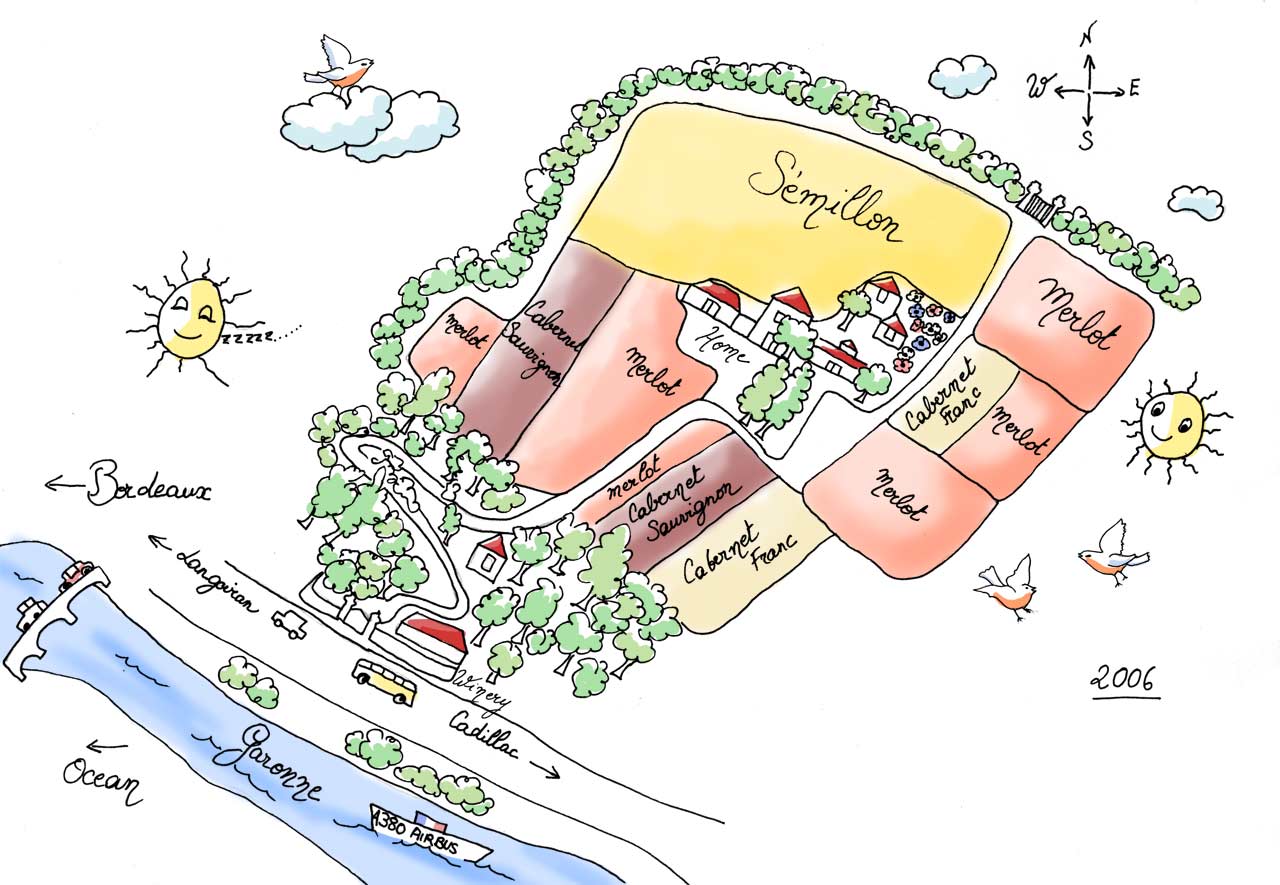
De 2006 à 2014, d’importants changements ont transformé le vignoble ; une analyse approfondie effectuée par Gilles Rey, notre consultant agricole, a révélé une surprenante diversité géologique des sols sur 9.7 hectares seulement.
2014
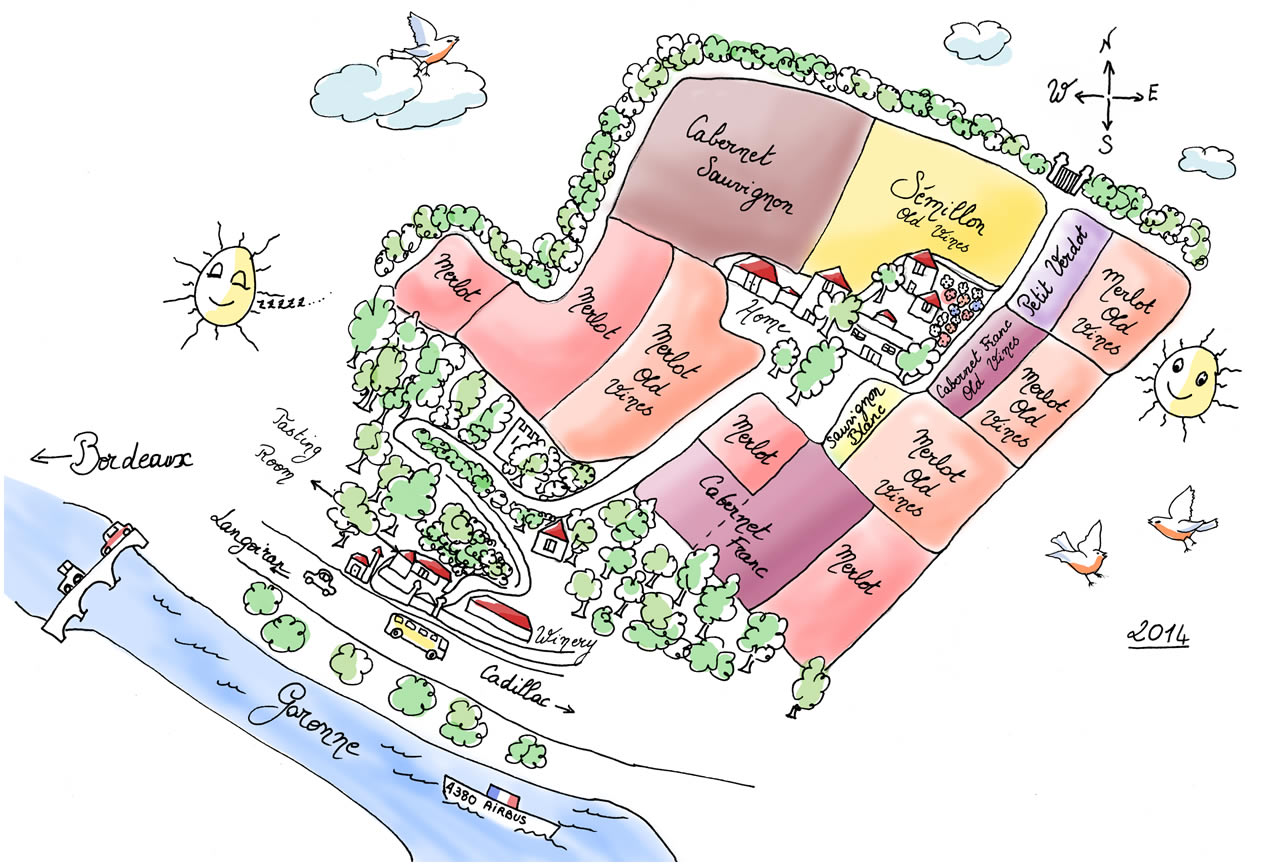
Les Graves (LG1)
Superficie
- 1.3747 ha
Composition du sol
- Partie supérieure : 100% Graviers
- Partie inférieure : Argile avec densité élevée de graviers
Variété de cépage
- Cabernet Sauvignon
Porte-greffe
- Partie supérieure supérieure, 114
- Partie inférieure, Riparia
Année de plantation
- 2008
Densité de la vigne par ha
- 9.100
Système de taille
- "Guyot double"
Les Graves (LG2)
Area
- 1.07 ha
Soil composition
- Top part: clay with high density gravel
- Bottom part: silty-clay with high density gravel
Grape Variety
- Semillon
Rootstock
- Unknown
Year of planting
- 1960
Density of vines per ha
- 5.000
Pruning style
- "Cot"
Chiquette 1
Area
- 0.2459 ha
Soil composition
- Clay with silt and sand (no gravel)
Grape Variety
- Petit Verdot, “selection massale” (propagating new vine stocks from a source of selected vines for their quality)
Rootstock
- 101-14
Year of planting
- 2008
Density of vines per ha
- 9.100
Pruning style
- “Guyot double”
Chiquette 2
Area
- 0.4341 ha
Soil composition
- Silt with clayey-sand, medium density gravel
Grape Variety
- Merlot Old Vines
Rootstock
- Unknown
Year of planting
- 1969
Density of vines per ha
- 5.000
Pruning style
- “Guyot double”
Sorbier
Area
- 0.6155 ha
Soil composition
- Sand with silty-clay, high density gravel
Grape Variety
- Merlots Old Vines and 9 rows of Cabernets Francs Old Vines
Rootstock
- Unknown
Year of planting
- 1968
Density of vines per ha
- 5.000
Pruning style
- “Guyot double”
Sorbier
Area
- 0.6155 ha
Soil composition
- Sand with silty-clay, high density gravel
Grape Variety
- Merlots Old Vines and 9 rows of Cabernets Francs Old Vines
Rootstock
- Unknown
Year of planting
- 1968
Density of vines per ha
- 5.000
Pruning style
- “Guyot double”
Garenne
Area
- 0.6013 ha
Soil composition
- Silt with clayey-sand, high density gravel
Grape Variety
- Merlot Old Vines except for 9 rows of Cabernets Francs in the bottom part next to two rows of table grapes!
Rootstock
- Unknown
Year of planting
- 1968
Density of vines per ha
- 5.000
Pruning style
- “Guyot double”
Verger
Area
- 0.1638 ha
Soil composition
- Silt with sand, light density gravel
Grape Variety
- Sauvignon blanc, “selection massale” (propagating new vine stocks from a source of selected vines for their quality)
Rootstock
- Not applicable
Year of planting
- 2009
Density of vines per ha
- 9.100
Pruning style
- “Guyot double”
Noël
Area
- 0.68 ha
Soil composition
- Clayey-chalk, medium density gravel
Grape Variety
- Merlot
Rootstock
- Top part: 3309
- Bottom part: Fercal
Year of planting
- 2012
Density of vines per ha
- 9.100
Pruning style
- “Guyot double”
Gaillard
Area
- 1.04
Soil composition
- Top part: silt with clayey-sand
- Bottom part: clayey-chalk, light gravel
Grape Variety
- 1/3 Merlot, 2/3 Cabernets Francs, both “selection massale” (propagating new vine stocks from a source of selected vines for their quality)
Rootstock
- Not applicable
Year of planting
- 2014
Density of vines per ha
- 9.100
Pruning style
- Not applicable
Gaillard
Area
- 1.04
Soil composition
- Top part: silt with clayey-sand
- Bottom part: clayey-chalk, light gravel
Grape Variety
- 1/3 Merlot, 2/3 Cabernets Francs, both “selection massale” (propagating new vine stocks from a source of selected vines for their quality)
Rootstock
- Not applicable
Year of planting
- 2014
Density of vines per ha
- 9.100
Pruning style
- Not applicable
Grand Journal (GJ2)
Area
- 1.0158 ha
Soil composition
- Top part: silt with clayey-sand, medium density gravel
- Bottom part: clayey chalk, medium density gravel
Grape Variety
- Merlot Old Vines
Rootstock
- Unknown
Year of planting
- 1967
Density of vines per ha
- 5.000
Pruning style
- “Guyot double”
Grand Journal (GJ1)
Area
- 0.717 ha
Soil composition
- Top part: sand with silty-clay, no gravel
- Center part: clay with silty sand , 50% gravel
- Bottom part: clayey-chalk, light density gravel
Grape Variety
- Merlot
Rootstock
- Top part: 3309
- Bottom part: Fercal
Year of planting
- 2011
Density of vines per ha
- 9.100
Pruning style
- “Guyot double”
Fer à cheval
Area
- 0.541 ha
Soil composition
- Top part: clay with silty-sand
- Bottom part: clayey-chalk
- Light gravel all over, more sand towards the bordering woods
Grape Variety
- Merlot
Rootstock
- Top part: 3309
- Bottom part: Fercal
- Towards the woods: Riparia
Year of planting
- 2010
Density of vines per ha
- 9.100
Pruning style
- “Guyot double”
Biac : une mosaïque de petites parcelles d’un seul tenant autour du Château , chacune ayant son identité géologique bien définie et différente de ses voisines favorisant ainsi la plantation d’un éventail de cépages , porte greffes et clones, nous vaut le surnom de « la Bourgogne en Bordelais ». Cliquez sur les parcelles individuelles pour découvrir leur composition de sol et de sous sol.
De la ville à la campagne, du béton à la terre !
Des rues fourmillantes de monde a la vision de milliers de vignes, du bruit des sirènes de police au chant des oiseaux et ronronnements des tracteurs, le 11 aout 2006 , nous nous sommes réveillés un peu étourdi du changement si extrême…
Très rapidement, nous réalisons la nécessité de nous entourer de véritables professionnels et… de faire le plein d’énergie : l’état du vignoble et du chai demandait une attention immédiate afin de pouvoir réaliser un vin en accord avec le potentiel et la réputation historique de Biac…
Trois rencontres vont être fondamentales envers la réalisation de notre engagement :
Christine Sourdes – œnologue conseil du Château Guiraud et Château de Myrat entre autres ; elle se laisse immédiatement séduire par nos Sémillons (et nous espérons également un peu par nous) ; grâce à sa connaissance approfondie de la région, Christine est capable de diriger de main de maître les premières vendanges de notre liquoreux : Secret de Château Biac nait en automne 2007 !
A l’automne 2008, Patrick Léon rentre en scène. Après sa dernière mission de 20 ans en tant que directeur technique des vignobles du Baron Philippe de Rothschild (dont Mouton Rothschild en France Opus One en Californie et Amalviva au Chili), Patrick avait créé sa compagnie de conseil pour des vignobles ã l’étranger et ne s’occupait à Bordeaux que de son vignoble familial ã Fronsac. Ayant souvent admiré Biac lors de passages à proximité, notre détermination à réaliser ce projet le convainc d’orchestrer nos vins rouges : Château Biac, B de Biac et Felix voient le jour avec le millésime 2008.
La présence ã nos côtés de Gilles Rey, ingénieur agricole, vient compléter cette équipe de choc !
Un plan de restructuration du vignoble est alors préparé. Sa mise en place nécessite 12 ans, pour ne pas baisser trop brutalement la moyenne d’âge des vignes. Des fosses profondes sont creusées pour cartographier les composants des sols ; là où la vigne semble plus fatiguée ou mal enracinée, nous passons en revue les cépages, porte-greffes et clones ; un drainage souterrain supplémentaire est installé pour éviter d’éventuelles poches d’eau ; les nouvelles vignes sont plantées à 1.10 entre rangs ; des sélections massales de grands crus sont incorporées : la tradition historique du 19ème siècle est ainsi renouvelée.
Gilles Rey remarque ne pas avoir rencontré dans la région autant de diversités de sols sur un si petit terroir qu’il qualifie de « terroir de poche »
Parallèlement, la restauration du chai commence en janvier 2007 avec comme but d’y rentrer le premier millésime en septembre 2007 : les vieux murs recouverts de ciment, une fois nettoyés révèlent de belles pierres anciennes ; une batterie de petites cuves thermo régulées en inox (17hl à 90 hl) vient s’y abriter ; un petit chai est construit à l’intérieur du grand chai pour permettre la vinification séparée du liquoreux.
TRAVAIL ET SAISONS
Durant l’année, nous apprenons très vite qu’un vignoble a besoin sans relâche d’attention. Nos experts sont là pour veiller à ce que personne ne l’oublie !
De saisons en saisons, de nombreuses tâches s’enchainent pour aider les vignes dans leur croissance à réaliser leur potentiel : la plupart des interventions sont manuelles, quant aux autres, tel que le labour, elles requièrent l’aide mécanique de tracteurs spécifiquement adaptés, les « enjambeurs », chevaux d’attrait moderne !
Grace à une remise en question globale des dernières décennies, de nouvelles pratiques agricoles sont accessibles en vue de corriger les excès d’utilisation de produits chimiques (pesticides et herbicides) tels qu’appliqués autrefois. Une approche beaucoup plus saine en résulte et les concepts de viticulture bio, bio dynamique et de culture raisonnée proposent des solutions bien plus en harmonie avec les défenses existantes dans la nature.
A Biac, la santé du vignoble est prise en charge comme si c’était la nôtre : nous appliquons une philosophie de prévention en appliquant une attention très particulière à la nutrition du sol afin que nos vignes puissent se développer sainement et fortifier leur résistance aux attaques des maladies pouvant les affecter. Les travaux de labour régulier (oxygénation du sol), d’amendement organique, de soins ponctuels sous l’œil vigilant de Gilles Rey, notre conseiller agricole, ont permis une remise visible ã l’œil nu de l’état du vignoble. Sa méthode qu’il a qualifiée de VIVARMONIE, pourrait se résumer par la recherche de l’harmonie du vivant. En viticulture, elle repose sur 4 grands concepts :
Une nutrition équilibrée « Que ton aliment soit ton meilleur médicament « (Hippocrate) ; une conduite adaptée à l’objectif de production ; des soins harmonisés et des énergies maitrisées : « Celui qui veut se perfectionner dans l’art de guérir considèrera comment l’endroit est dispose et s’informera du sous-sol, concurremment avec la constitution des êtres vivants » (Hippocrate)
- HIVER
- PRINTEMPS
- ÉTË
- AUTOMNE
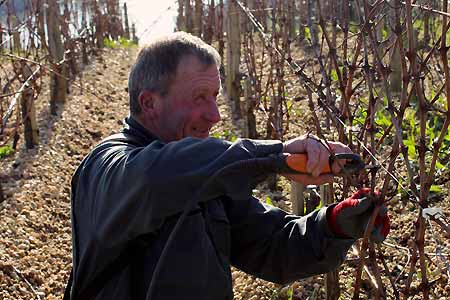
Winter
The working cycle starts in winter: after harvest, once the sap has gone down back into the roots, the leaves fall and pruning can start. It is a long meticulous process which will last all winter. Each varietal requires a careful approach to ensure proper growth for the next vintage.
One last deep ploughing and covering of the vine roots (cavaillonage) with soil for winter protection takes place.
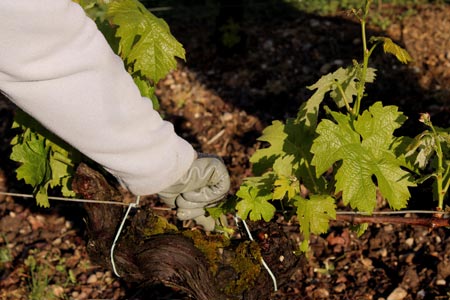
Spring
The pruned vine shoots are collected in bunches or crushed into the soil (some are kept for summer barbecues!). The stems are tied to a wire and the base of the vine is secured to the wooden post. It is then cleared from its winter covering (decavaillonage) and desuckering can begin. Grass mowing and ploughing take place when needed and support wires are raised for the first time to ensure vertical growth of the vines.
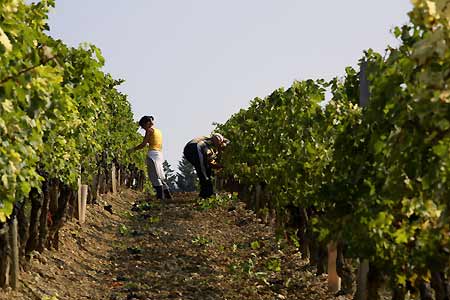
Summer
Further desuckering and lifting of the support wires take place during the month of June quickly followed early July by deleafing on the East side of the vines to allow the summer sun to ripen our grapes. Green harvesting (or crop thinning) will also take place shortly after. Late August, as days get shorter and afternoon sunshine cooler deleafing on the West side of the vines will be carried out to help the ripening process : as we get close to autumnal rains, we also want as much airflow to go through our grapes to protect them from possible rot ; sometimes, depending on the length of time it takes for the “veraison” to happen, a second crop thinning is necessary to ensure homogenous maturity come harvest time. Throughout the summer, capping of the leaf canopy , grass mowing and ploughing continues at regular intervals.
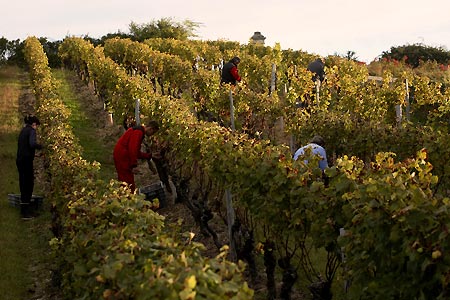
Autumn
Harvest time… At last!
During the weeks prior to harvesting, one can feel a real buzz in the Bordeaux region.
Everyone is watching the weather, washing the vats, cleaning the sorting tables, the harvesting baskets, preparing harvest menus, and holding their breaths: for until the last grape is collected, sorted and eased into the vat, will we be weary of Oceanic capricious weather fronts and how quickly they can destroy one year’s hard labor!
LES VENDAGES
L’aboutissement d’une année de travail, le moment pour lequel nous avons tous travaillé, en faisant face aux multiples défis que l’année nous a présentés… C’est aussi le temps de joyeux déjeuners et dîners avec notre équipe dévouée ! Si vous passez dans la région à cette époque de l’année, n’hésitez pas à venir nous voir !
- VIN ROUGE
- VIN LIQUOREUX
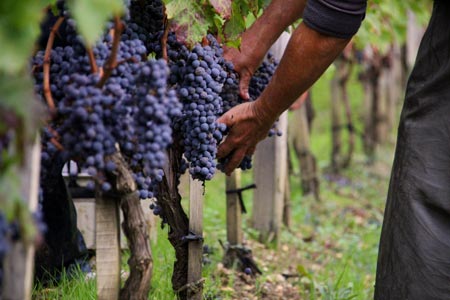
Sorting at the vine…
The green harvesting in the summer has ensured that only the best bunches have remained and have benefited fully from the rich nutrients our soil provides. However, when cutting the bunches, our pickers make sure they are all healthy prior to placing them in small baskets. Any undesired bits are cut off and discarded.
From the vineyard to the winery
The baskets holding no more than 9 kilos of grapes are quickly transported to the winery. A clever system, as shown in the photo, allows the baskets to sit on top of each other without crushing the grapes in the ones below.
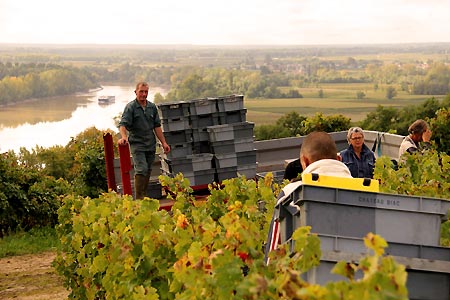
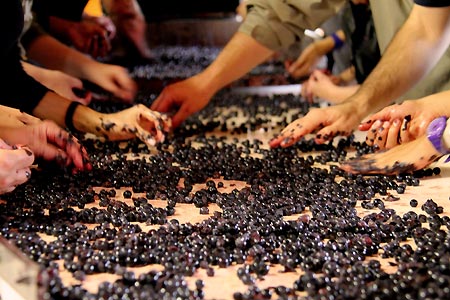
Sorting (again) at the winery
The baskets are trucked at quick, regular intervals to the winery, then carefully emptied one by one onto a vibrating table where members of the home team will check the bunches of grapes once more before they go into the destemming and sorting machine. Finally, the selected berries travel along a conveyor belt where 12 of our most trusted team members make sure that nothing but the best go through to the crusher. They are then directed through a pipe towards the day’s dedicated vat, by natural gravity thanks to the existing incline of our land.
Needless to say that when you spend all this time working together, many secrets are revealed over the table… But the grapes take them to the vats to be drowned in lush, aromatic juice!
Into the vat
The selected grapes will finish their journey by flowing gently through a pipe towards the day’s dedicated vat in the winery, using natural gravity created by the existing natural incline of our property: no pumps, no lifts, just gentle gravity for the grapes to be handled with the utmost care. Another chapter begins….

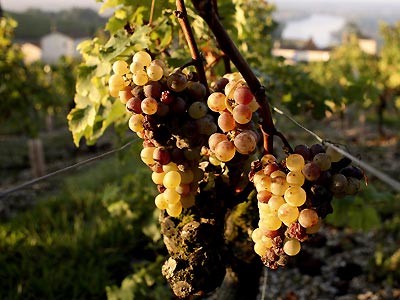
Noble rot (“Botrytis Cinerara”)
Who ever dreamt that a rotten grape complete with hairy fuzz and ugly wrinkles would give birth to the wine of the Gods: liquid gold!
There are many stories of how this came to be, but none has the one claim of veracity!
In a nutshell: the autumnal fog travelling up our hill from the Garonne River gives birth to a fungus: “Botrytis Cinerara” which attacks the grapes and pierces their skin. They shrivel and a layer of hairy fuzz coats them. Then the autumnal sunshine (we hope) comes to the rescue by drying out the rot and the water (by evaporation), thereby concentrating their sugar level. Unexpected aromas of apricot, orange marmalade, white peaches, and pears develop! These are the grapes we will pick. This particular bunch shows several stages of “noble rot” from ready to pick (dark and shriveled) to waiting to rot! (golden)
It is one of the specific characters of Château Biac, that we can produce sweet wines, red wines and dry white wines side by side: another amazing feat of this exceptional “terroir”…
Which rotten grapes?
We pick mostly one grape at a time avoiding injuring the remaining ones. Sometimes, lucky pickers find whole bunches as above! However, sour rot or white rot can also develop: these give vinegar like aromas to the grapes and are to be avoided at all cost: our pickers are chosen for their ability to recognize the good rot from the bad ones! Ultimately, when in doubt, we taste!
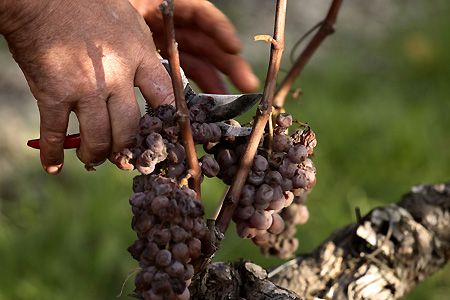
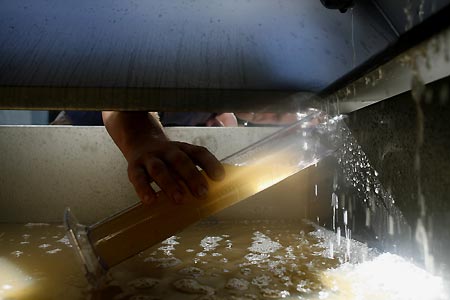
Journey to the winery...
The sweet wine grapes are brought to the winery in their individual baskets. We check them once more before they are carefully placed in a horizontal hydraulic press, programmed to gently extract the juice over several hours.
... And to the barrel
The juice will then spend some time in a vat at a very low temperature before being transferred into new French oak barrels to begin its alcoholic fermentation.
A new vintage is in the making…
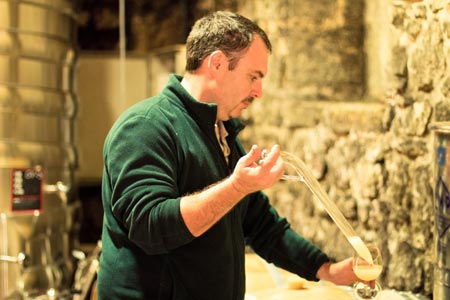
LE VIE DANS LE CHAI
Lorsque nous sommes arrivés en 2006, nous avons trouvé le chai en pauvre état ; il était urgent de le moderniser si nous voulions en faire un outil moderne de qualité, nous permettant de produire un vin correspondant au potentiel du terroir de Biac ainsi qu’à nos espérances et celles de nos consultants. Aujourd’hui, le chai de Biac a retrouvé sa splendeur, tout en restant fidèle à son histoire : les anciens murs de pierre retrouvés sous de multiples couches d’enduit abritent une technologie adaptée aux exigences de notre équipe, alliant tradition et modernité, toujours à la recherche de l’excellence.
Dans le cuvier, une batterie de petites cuves à thermorégulateurs intégrés a été sélectionnée pour gérer les récoltes indépendamment les unes des autres, selon les vendanges de chaque parcelle ou sous-parcelle de cépages plantés.
- VIN ROUGE
- VIN LIQUOREUX

Delicious ripened grapes carefully handpicked and sorted, fall by gravity into the vats.

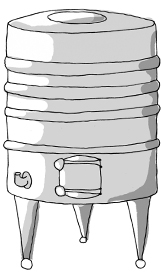
In the dedicated thermoregulated vat, the grapes get to work and convert their sugar into alcohol (alcoholic fermentation); pumping over (remontage) is applied following our teams’ careful tutoring and directions: tannins are softly extracted from the pips and color from the skins. Once this first fermentation is done, the wine (vin de goutte) is transferred to the barrels.

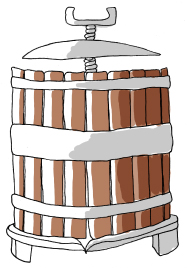
The remaining pulp, pips and skins are then pressed and their juice (“vin de presse”) is set aside in separate barrels. What happens to the “PPS” (pulp, pips and skins)? It is sent to the local distillery! As required by French law!

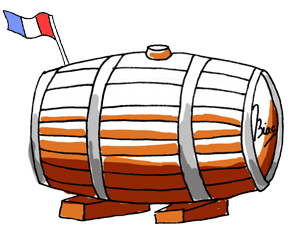
HO2CCH2CHOHCO2H to C3H6O3: Malo-lactic fermentation! Don’t ask! But thanks to this formula, the wine loses its roughness and becomes more palatable; about 40% of our wine will undergo this fermentation in barrels , the rest in the vats.
We use mostly (90%) French oak barrels chosen from a selection of French barrel makers re-assessed every year, the rest being Austro German oak; typically 40-50% new barrels, 40% barrels used once and 10% used twice. During the year, we will hold regular in house tastings with our oenologists and our team to monitor the evolution of our wines in the different barrels.


The wine ages approximately 14 to 16 months in the barrels; we try to make sure that the oak does not overpower the fruit, instead, it should enhance the aromas and help the tannins….
Apparently, we are not the only ones tasting our wines …as it evolves during its ageing time in the barrels, we lose about 10% of the initial volume…commonly called “the angel share”: perhaps you can catch a glimpse of them at night….?

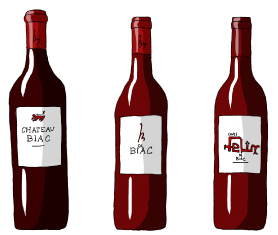
Bottling takes place inside the winery using the services of a very meticulous bottling company. Various bottles sizes are filled with Biac wine ; the bottles are then laid down in our bottle stocking building to rest from the process. they will be released to the market 6 months later …Another journey which began almost two years before in the vineyard, can start…
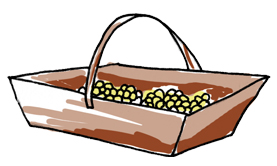
Château Biac has this amazing particularity of being able to produce red, dry white and sweet white wines on a very small terroir


The juice from the selected grapes (usually 100% semillon) is extracted straightaway after picking, but not before they have been checked once more to be properly “ rotten”! and to avoid bad rot which can let out an awful sour smell !
The grapes are pressed in a hydraulic horizontal press (unlike this wooden traditional one!). The pressing time is carefully monitored so as not to shock the grapes , and the juice is extracted gently over several hours..


The juice is then placed into a vat, where overnight, it is maintained at low temperature which precipitates the remaining sediments (or “bourbes”) to the bottom.


The next day, a delicate operation takes place: the clear juice above the sediments must be carefully extracted to be placed in new French oak barrels where it will start its alcoholic fermentation.


Our sweet wine will develop its aromas and age over a period of 14 to 16 months before being bottled. However small the production and depending on the vintage, we feel obliged to let our guardian angels who work so hard looking after the red wine, the ultimate luxury of tasting the sweet wine too!


“Secret de Château Biac” is a tribute to the unique situation of the vineyard. Very few properties if any in Bordeaux, have the ability to make sweet wine from a plot in the midst of red wine making vines on 9.5 hectares only! And so, when the time is right, it is finally bottled alongside its red brother…